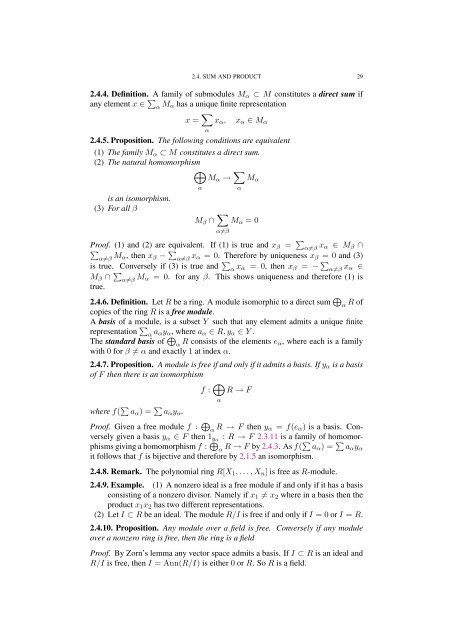Commutative algebra - Department of Mathematical Sciences - old ...
Commutative algebra - Department of Mathematical Sciences - old ...
Commutative algebra - Department of Mathematical Sciences - old ...
You also want an ePaper? Increase the reach of your titles
YUMPU automatically turns print PDFs into web optimized ePapers that Google loves.
2.4. SUM AND PRODUCT 29<br />
2.4.4. Definition. A family <strong>of</strong> submodules Mα ⊂ M constitutes a direct sum if<br />
any element x ∈ <br />
α Mα has a unique finite representation<br />
x = <br />
xα, xα ∈ Mα<br />
2.4.5. Proposition. The following conditions are equivalent<br />
(1) The family Mα ⊂ M constitutes a direct sum.<br />
(2) The natural homomorphism<br />
<br />
Mα → <br />
is an isomorphism.<br />
(3) For all β<br />
α<br />
α<br />
α<br />
Mα<br />
Mβ ∩ <br />
Mα = 0<br />
α=β<br />
Pro<strong>of</strong>. (1) and (2) are equivalent. If (1) is true and xβ = <br />
α=β xα ∈ Mβ ∩<br />
<br />
α=β Mα, then xβ − <br />
α=β xα = 0. Therefore by uniqueness xβ = 0 and (3)<br />
is true. Conversely if (3) is true and <br />
α xα = 0, then xβ = − <br />
α=β xα ∈<br />
Mβ ∩ <br />
α=β Mα = 0. for any β. This shows uniqueness and therefore (1) is<br />
true.<br />
2.4.6. Definition. Let R be a ring. A module isomorphic to a direct sum <br />
α<br />
R <strong>of</strong><br />
copies <strong>of</strong> the ring R is a free module.<br />
A basis <strong>of</strong> a module, is a subset Y such that any element admits a unique finite<br />
representation <br />
α aαyα, where aα ∈ R, yα ∈ Y .<br />
The standard basis <strong>of</strong> <br />
α R consists <strong>of</strong> the elements eα, where each is a family<br />
with 0 for β = α and exactly 1 at index α.<br />
2.4.7. Proposition. A module is free if and only if it admits a basis. If yα is a basis<br />
<strong>of</strong> F then there is an isomorphism<br />
f : <br />
R → F<br />
where f( aα) = aαyα.<br />
α<br />
Pro<strong>of</strong>. Given a free module f : <br />
α R → F then yα = f(eα) is a basis. Conversely<br />
given a basis yα ∈ F then 1yα : R → F 2.3.11 is a family <strong>of</strong> homomorphisms<br />
giving a homomorphism f : <br />
α R → F by 2.4.3. As f( aα) = aαyα<br />
it follows that f is bijective and therefore by 2.1.5 an isomorphism.<br />
2.4.8. Remark. The polynomial ring R[X1, . . . , Xn] is free as R-module.<br />
2.4.9. Example. (1) A nonzero ideal is a free module if and only if it has a basis<br />
consisting <strong>of</strong> a nonzero divisor. Namely if x1 = x2 where in a basis then the<br />
product x1x2 has two different representations.<br />
(2) Let I ⊂ R be an ideal. The module R/I is free if and only if I = 0 or I = R.<br />
2.4.10. Proposition. Any module over a field is free. Conversely if any module<br />
over a nonzero ring is free, then the ring is a field<br />
Pro<strong>of</strong>. By Zorn’s lemma any vector space admits a basis. If I ⊂ R is an ideal and<br />
R/I is free, then I = Ann(R/I) is either 0 or R. So R is a field.
















